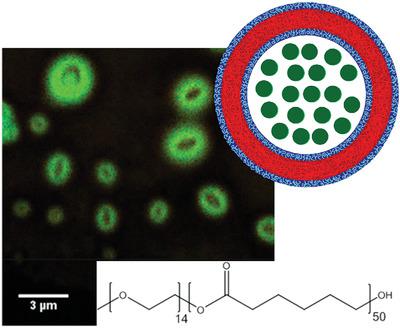当前位置:
X-MOL 学术
›
Macromol. Biosci.
›
论文详情
Our official English website, www.x-mol.net, welcomes your
feedback! (Note: you will need to create a separate account there.)
Giant Biodegradable Poly(ethylene glycol)-block-Poly(ε-caprolactone) Polymersomes by Electroformation.
Macromolecular Bioscience ( IF 4.4 ) Pub Date : 2020-05-03 , DOI: 10.1002/mabi.202000014 Cleiton Kunzler 1, 2 , Stephan Handschuh-Wang 1 , Manuel Roesener 1 , Holger Schönherr 1
Macromolecular Bioscience ( IF 4.4 ) Pub Date : 2020-05-03 , DOI: 10.1002/mabi.202000014 Cleiton Kunzler 1, 2 , Stephan Handschuh-Wang 1 , Manuel Roesener 1 , Holger Schönherr 1
Affiliation

|
Here, the formation of giant enzyme‐degradable polymersomes using the electroformation method is reported. Poly(ethylene glycol)‐block‐poly(ε‐caprolactone) polymersomes have been shown previously to be attractive candidates for the detection of bacterial proteases and protease mediated release of encapsulated reporter dyes and antimicrobials. To maximize the efficiency, the maximization of block copolymer (BCP) vesicle size without compromising their properties is of prime importance. Thus, the physical‐chemical properties of the BCP necessary to self‐assemble into polymeric vesicles by electroformation are first identified. Subsequently, the morphology of the self‐assembled structures is extensively characterized by different microscopy techniques. The vesicular structures are visualized for giant polymersomes by confocal laser scanning microscopy upon incorporation of reporter dyes during the self‐assembly process. Using time correlated single photon counting and by analyzing the fluorescence decay curves, the nanoenvironment of the encapsulated fluorophores is unveiled. Using this approach, the hollow core structure of the polymersomes is confirmed. Finally, the encapsulation of different dyes added during the electroformation process is studied. The results underline the potential of this approach for obtaining microcapsules for subsequent triggered release of signaling fluorophores or antimicrobially active cargo molecules that can be used for bacterial infection diagnostics and/or treatment.
中文翻译:

巨大的可生物降解聚(乙二醇)-嵌段-聚(ε-己内酯)聚合物体通过电成型。
在这里,报道了使用电铸法形成巨大的酶可降解聚合物囊泡。聚(乙二醇)-嵌段聚(ε-己内酯)聚合物囊泡先前已被证明是检测细菌蛋白酶和蛋白酶介导的封装报告染料和抗菌剂释放的有吸引力的候选物。为了最大限度地提高效率,在不影响其性能的情况下最大化嵌段共聚物 (BCP) 囊泡尺寸至关重要。因此,首先确定了通过电成型自组装成聚合物囊泡所需的 BCP 的物理化学性质。随后,自组装结构的形态被不同的显微镜技术广泛表征。在自组装过程中加入报告染料后,通过共聚焦激光扫描显微镜观察巨型聚合物囊泡结构。使用时间相关的单光子计数并通过分析荧光衰减曲线,揭示了封装荧光团的纳米环境。使用这种方法,聚合物囊泡的空心结构得到证实。最后,研究了电铸过程中添加的不同染料的封装。结果强调了这种方法获得微胶囊的潜力,用于随后触发释放信号荧光团或可用于细菌感染诊断和/或治疗的抗菌活性货物分子。研究了在电铸过程中添加的不同染料的封装。结果强调了这种方法获得微胶囊的潜力,用于随后触发释放信号荧光团或可用于细菌感染诊断和/或治疗的抗菌活性货物分子。研究了在电铸过程中添加的不同染料的封装。结果强调了这种方法获得微胶囊的潜力,用于随后触发释放信号荧光团或可用于细菌感染诊断和/或治疗的抗菌活性货物分子。
更新日期:2020-05-03
中文翻译:

巨大的可生物降解聚(乙二醇)-嵌段-聚(ε-己内酯)聚合物体通过电成型。
在这里,报道了使用电铸法形成巨大的酶可降解聚合物囊泡。聚(乙二醇)-嵌段聚(ε-己内酯)聚合物囊泡先前已被证明是检测细菌蛋白酶和蛋白酶介导的封装报告染料和抗菌剂释放的有吸引力的候选物。为了最大限度地提高效率,在不影响其性能的情况下最大化嵌段共聚物 (BCP) 囊泡尺寸至关重要。因此,首先确定了通过电成型自组装成聚合物囊泡所需的 BCP 的物理化学性质。随后,自组装结构的形态被不同的显微镜技术广泛表征。在自组装过程中加入报告染料后,通过共聚焦激光扫描显微镜观察巨型聚合物囊泡结构。使用时间相关的单光子计数并通过分析荧光衰减曲线,揭示了封装荧光团的纳米环境。使用这种方法,聚合物囊泡的空心结构得到证实。最后,研究了电铸过程中添加的不同染料的封装。结果强调了这种方法获得微胶囊的潜力,用于随后触发释放信号荧光团或可用于细菌感染诊断和/或治疗的抗菌活性货物分子。研究了在电铸过程中添加的不同染料的封装。结果强调了这种方法获得微胶囊的潜力,用于随后触发释放信号荧光团或可用于细菌感染诊断和/或治疗的抗菌活性货物分子。研究了在电铸过程中添加的不同染料的封装。结果强调了这种方法获得微胶囊的潜力,用于随后触发释放信号荧光团或可用于细菌感染诊断和/或治疗的抗菌活性货物分子。











































 京公网安备 11010802027423号
京公网安备 11010802027423号